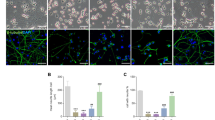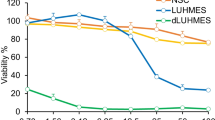Abstract
Suppression of ubiquitin proteasome pathway (UPP) and stimulation of caspase-3 are involved in neurodegeneration. Can UPP activators and caspase-3 inhibitors ameliorate neurodegeneration? Here, we found a novel neuronal cell death accompanied with UPP activation and caspase-3 inhibition. Recently, plasmalemmal neuron-specific enolase (NSE) has been identified as one of membrane targets of 15-deoxy-Δ12,14-prostaglandin J2 (15d-PGJ2). 15d-PGJ2 induces neuronal apoptosis via activating caspase-3 and inactivating UPP, whereas the anti-NSE antibody inactivated caspase-3, activated UPP, and caused neuronal cell death. The anti-NSE antibody activated caspase-1 (pyroptosis marker), but not condense chromatin (apoptosis marker). The anti-NSE antibody declined intracellular level of ATP, which is not altered in pyroptosis. The intracellular level of calcium is elevated in necrosis and pyroptosis, but its chelator did not ameliorate the neurotoxicity of anti-NSE. Thiol antioxidants such as N-acetyl cysteine and glutathione reduced the neurotoxicity of 15d-PGJ2 but enhanced that of the anti-NSE antibody. The anti-NSE antibody incorporated propidium iodide into neurons through the disrupted plasma membrane, which are not observed in ferroptosis and autophagic cell death. Thus, the anti-NSE antibody induced neuronal cell death in a novel fashion distinguished from necrosis, necroptosis, apoptosis, pyroptosis, ferroptosis, and autophagic cell death.








Similar content being viewed by others
References
Yagami T, Yamamoto Y, Koma H (2019) Pathophysiological roles of intracellular proteases in neuronal development and neurological diseases. Mol Neurobiol 56(5):3090–3112
Kerr JF, Wyllie AH, Currie AR (1972) Apoptosis: a basic biological phenomenon with wide-ranging implications in tissue kinetics. Br J Cancer 26(4):239–257
Galluzzi L, Vitale I, Abrams JM, Alnemri ES, Baehrecke EH, Blagosklonny MV, Dawson TM, Dawson VL et al (2012) Molecular definitions of cell death subroutines: recommendations of the Nomenclature Committee on Cell Death 2012. Cell Death Differ 19(1):107–120
Tan S, Sagara Y, Liu Y, Maher P, Schubert D (1998) The regulation of reactive oxygen species production during programmed cell death. J Cell Biol 141(6):1423–1432
Yagami T, Yamamoto Y, Koma H (2017) Physiological and pathological roles of 15-deoxy-delta12,14-prostaglandin J2 in the central nervous system and neurological diseases. Mol Neurobiol
Iwamoto N, Kobayashi K, Kosaka K (1989) The formation of prostaglandins in the postmortem cerebral cortex of Alzheimer-type dementia patients. J Neurol 236(2):80–84
Gaudet RJ, Alam I, Levine L (1980) Accumulation of cyclooxygenase products of arachidonic acid metabolism in gerbil brain during reperfusion after bilateral common carotid artery occlusion. J Neurochem 35(3):653–658
Fitzpatrick FA, Wynalda MA (1983) Albumin-catalyzed metabolism of prostaglandin D2. Identification of products formed in vitro. J Biol Chem 258(19):11713–11718
Shibata T, Kondo M, Osawa T, Shibata N, Kobayashi M, Uchida K (2002) 15-deoxy-delta 12,14-prostaglandin J2. A prostaglandin D2 metabolite generated during inflammatory processes. J Biol Chem 277(12):10459–10466
Yagami T, Ueda K, Asakura K, Takasu N, Sakaeda T, Itoh N, Sakaguchi G, Kishino J et al (2003) Novel binding sites of 15-deoxy-delta12,14-prostaglandin J2 in plasma membranes from primary rat cortical neurons. Exp Cell Res 291(1):212–227
Yagami T, Yamamoto Y, Koma H (2017) 15-deoxy-Delta12,14-prostaglandin J2 in neurodegenerative diseases and cancers. Oncotarget 8(6):9007–9008
Koma H, Yamamoto Y, Nishii A, Yagami T (2017) 15-Deoxy-delta12,14-prostaglandin J2 induced neurotoxicity via suppressing phosphoinositide 3-kinase. Neuropharmacology 113(Pt A):416–425
Mullally JE, Moos PJ, Edes K, Fitzpatrick FA (2001) Cyclopentenone prostaglandins of the J series inhibit the ubiquitin isopeptidase activity of the proteasome pathway. J Biol Chem 276(32):30366–30373
Love S, Saitoh T, Quijada S, Cole GM, Terry RD (1988) Alz-50, ubiquitin and tau immunoreactivity of neurofibrillary tangles, pick bodies and Lewy bodies. J Neuropathol Exp Neurol 47(4):393–405
Kawasaki H, Murayama S, Tomonaga M, Izumiyama N, Shimada H (1987) Neurofibrillary tangles in human upper cervical ganglia. Morphological study with immunohistochemistry and electron microscopy. Acta Neuropathol 75(2):156–159
Arnaud LT, Myeku N, Figueiredo-Pereira ME (2009) Proteasome-caspase-cathepsin sequence leading to tau pathology induced by prostaglandin J2 in neuronal cells. J Neurochem 110(1):328–342
Yamamoto Y, Koma H, Yagami T (2015) Localization of 14-3-3delta/xi on the neuronal cell surface. Exp Cell Res 338(2):149–161
Yamamoto Y, Takase K, Kishino J, Fujita M, Okamura N, Sakaeda T, Fujimoto M, Yagami T (2011) Proteomic identification of protein targets for 15-deoxy-delta(12,14)-prostaglandin J2 in neuronal plasma membrane. PLoS One 6(3):e17552
Yagami T, Ueda K, Asakura K, Hata S, Kuroda T, Sakaeda T, Takasu N, Tanaka K et al (2002) Human group IIA secretory phospholipase A2 induces neuronal cell death via apoptosis. Mol Pharmacol 61(1):114–126
Yamamoto Y, Fujita M, Koma H, Yamamori M, Nakamura T, Okamura N, Yagami T (2011) 15-Deoxy-delta12,14-prostaglandin J2 enhanced the anti-tumor activity of camptothecin against renal cell carcinoma independently of topoisomerase-II and PPARgamma pathways. Biochem Biophys Res Commun 410(3):563–567
Yagami T, Yamamoto Y, Kohma H, Nakamura T, Takasu N, Okamura N (2013) L-type voltage-dependent calcium channel is involved in the snake venom group IA secretory phospholipase A2-induced neuronal apoptosis. Neurotoxicology 35:146–153
Yamamoto Y, Koma H, Yagami T (2015) Hydrogen peroxide mediated the neurotoxicity of an antibody against plasmalemmal neuronspecific enolase in primary cortical neurons. Neurotoxicology 49:86–93
Yamamoto Y, Koma H, Nishii S, Yagami T (2017) Anti-heat shock 70 kDa protein antibody induced neuronal cell death. Biol Pharm Bull 40(4):402–412
Yagami T, Ueda K, Asakura K, Nakazato H, Hata S, Kuroda T, Sakaeda T, Sakaguchi G et al (2003) Human group IIA secretory phospholipase A2 potentiates Ca2+ influx through L-type voltage-sensitive Ca2+ channels in cultured rat cortical neurons. J Neurochem 85(3):749–758
Yagami T, Ueda K, Asakura K, Sakaeda T, Hata S, Kuroda T, Sakaguchi G, Itoh N et al (2003) Porcine pancreatic group IB secretory phospholipase A2 potentiates Ca2+ influx through L-type voltage-sensitive Ca2+ channels. Brain Res 960(1–2):71–80
Zhang WH, Wang X, Narayanan M, Zhang Y, Huo C, Reed JC, Friedlander RM (2003) Fundamental role of the Rip2/caspase-1 pathway in hypoxia and ischemia-induced neuronal cell death. Proc Natl Acad Sci U S A 100(26):16012–16017
Ueda K, Shinohara S, Yagami T, Asakura K, Kawasaki K (1997) Amyloid beta protein potentiates Ca2+ influx through L-type voltage-sensitive Ca2+ channels: a possible involvement of free radicals. J Neurochem 68(1):265–271
Antunes F, Cadenas E (2000) Estimation of H2O2 gradients across biomembranes. FEBS Lett 475(2):121–126
Ha JS, Lee JE, Lee JR, Lee CS, Maeng JS, Bae YS, Kwon KS, Park SS (2010) Nox4-dependent H2O2 production contributes to chronic glutamate toxicity in primary cortical neurons. Exp Cell Res 316(10):1651–1661
Gdynia G, Grund K, Eckert A, Bock BC, Funke B, Macher-Goeppinger S, Sieber S, Herold-Mende C et al (2007) Basal caspase activity promotes migration and invasiveness in glioblastoma cells. Mol Cancer Res 5(12):1232–1240
Saito T, Ishida J, Takimoto-Ohnishi E, Takamine S, Shimizu T, Sugaya T, Kato H, Matsuoka T et al (2004) An essential role for angiotensin II type 1a receptor in pregnancy-associated hypertension with intrauterine growth retardation. FASEB J 18(2):388–390
Seiler A, Schneider M, Forster H, Roth S, Wirth EK, Culmsee C, Plesnila N, Kremmer E et al (2008) Glutathione peroxidase 4 senses and translates oxidative stress into 12/15-lipoxygenase dependent- and AIF-mediated cell death. Cell Metab 8(3):237–248
Acknowledgments
The authors would like to thank Mr. Hiroaki Kumagai for supporting this study.
Funding
The work presented in the submitted manuscript was funded by Grant-in-Aid 17K08327 from the Ministry of Education, Culture, Sports, Science, and Technology of Japan.
Author information
Authors and Affiliations
Corresponding author
Ethics declarations
Conflict of Interest
The authors declare that they have no conflict of interest.
Additional information
Publisher’s Note
Springer Nature remains neutral with regard to jurisdictional claims in published maps and institutional affiliations.
Electronic supplementary material
Supplemental data 1
Antibodies against NSE and HSP70 reduced inactive pro-caspase-1. Neurons were treated without or with normal goat IgG (400 ng/mL), anti-NSE antibody (400 ng/mL), anti-HSP70 antibody (400 ng/mL) or 15d-PGJ2 (3 or 4 μM) for 24 h. Pro-caspase-1 and caspase-1 of neuronal cell lysates were separated by SDS-PAGE, and detected by immunoblotting with anti-procaspase-1 antibody (AI 1156 kb)
Supplemental data 2
Effect of BAPTA-AM on the neurotoxicity of antibodies against NSE and HSP70. Neurons (7DIV) were treated with BAPTA-AM at the indicated concentrations in the absence (circles) or presence of 200 ng/mL anti-NSE antibody (triangles) and 200 ng/mL anti-HSP70 antibody (squares) for 48 h. Cell viabilities were determined by MTT reducing activity. Data are expressed as means ± SE. (n = 3). *P < 0.05 and **P < 0.01, compared with control (AI 1191 kb)
Supplemental data 3
Effects of MAP kinase inhibitors on the neurotoxicity of antibodies against NSE and HSP70. Neurons were treated with U0126 (A), SB202190 (B) or SP600125 (C) at the indicated concentrations in the absence (circles; control) or presence of normal goat IgG (triangles; 200 ng/mL) or the anti-HSP antibody (squares; 200 ng/mL). (D) Neurons were treated with SP600125 at the indicated concentrations in the absence (open circles; control) or presence of normal goat IgG (open triangles; 200 ng/mL), the anti-NSE antibody (open squares; 200 ng/mL) or 15d-PGJ2 (closed circles; 3.5 μM). Cell viabilities were determined by MTT reducing activity. Data are expressed as means ± SD. (n = 3). *P < 0.05, **P < 0.01, compared with the normal goat IgG alone and #P < 0.05, ##P < 0.01, compared with the anti-HSP70 antibody alone (AI 1232 kb)
ESM 4
(AI 1237 kb)
ESM 5
(AI 1243 kb)
ESM 6
(AI 1238 kb)
Rights and permissions
About this article
Cite this article
Yamamoto, Y., Koma, H. & Yagami, T. The Anti-Neuron-Specific Enolase Antibody Induced Neuronal Cell Death in a Novel Fashion. Mol Neurobiol 57, 2265–2278 (2020). https://doi.org/10.1007/s12035-020-01876-8
Received:
Accepted:
Published:
Issue Date:
DOI: https://doi.org/10.1007/s12035-020-01876-8




